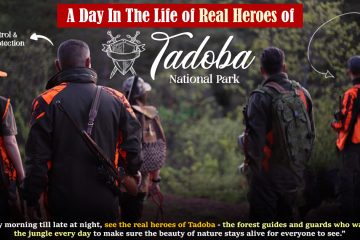Tadoba National Park is a well-known wildlife park located in Maharashtra, India. It is home to many tigers, along with different types of other animals and birds, and you can go on a Tadoba safari to see them. The reserve was recently much distressed when one of its local tigers, a female tiger TF-3, became a trouble to the nearby human villages and areas. This tiger, who had been living peacefully in Tadoba National Park before, began to develop aggressive behavior.
TF-3 attacked humans, and this resulted in horrific deaths and injuries. The matter was further complicated by the fact that TF-3 had three young cubs. The cubs were left in the wild when their mother was brought into captivity, and they were in danger. To rescue the villagers and save the cubs, the forest authorities decided to carry out a difficult but necessary rescue operation. This process not only removed the threat to the tiger but also saved the cubs, who otherwise would have been exposed to numerous dangers.
The Problem With TF-3
TF-3 was a tigress who had lived in the Tadoba National Park for many years. She was a part of the ecosystem and played an important role in the wildlife balance in the reserve. However, recently, her behavior changed. TF-3 began attacking people who lived near the park. Over a period of about nine months, TF-3 killed four people and injured three others. These attacks caused great fear in the nearby human settlements, and the villagers were scared of her.
They no longer felt safe living near the reserve. The authorities recognized that they must act to secure the people. At the same time, the forest department did not want to do any harm to TF-3 or her cubs unnecessarily. The authorities must carefully consider how to handle TF-3 without overthinking its broader effect on the wildlife population. They agreed that TF-3 needed to be captured in order to safeguard the lives of the villagers, but they also realized that they would have to figure out how to take care of her cubs.
The Cubs Left Behind
When the authorities captured TF-3, they were left with the problem of what to do with her cubs. These cubs were still very young and completely dependent on their mother for survival. Without her, the cubs were at great risk. They could die from starvation, dehydration or be attacked by other animals. The Tadoba National Park is a difficult place for young animals, especially for tigers, who need their mother’s protection to survive. The cubs were also vulnerable to the harsh weather and heat of the reserve. In the wild, young tigers would stay with their mother for a long time, learning how to hunt and survive. But now that their mother was gone, the cubs had no one to care for them. The forest department understood that they had to act quickly to save the cubs.
The Rescue Operation
The authorities knew they had to rescue the cubs as soon as possible. They quickly put together a team to find and capture the cubs safely. The team was headed by two forest department officers named Priyanka Velme and Vinod Dhurve, who managed the work. The team included about 100 people, and they used many tools and technologies to help them in their mission. Drones were used to cover large areas of the reserve and find the cubs. The drones could fly over the forest and take pictures, which helped the team track the cubs’ movements. Camera traps, which are devices that take pictures of animals, were set up to give the team more information about where the cubs were. These traps helped the team learn where the cubs were hiding and how they were behaving.
The team also used specially designed trap-nets. These nets were meant to capture the cubs safely without causing them any harm. The rescue operation was carefully planned and took around six hours to complete. Every moment was important. The team worked together to find and capture all three cubs. It was difficult work, and the team had to be very careful to avoid hurting the cubs. They had to make sure the cubs were captured safely and could be looked after properly. After several hours of searching, the team finally managed to locate all three cubs. They were captured and brought to safety, away from the dangers of the wild. The operation was a success, and the cubs were no longer at risk.
The Cubs Are Safe Now
The cubs were rescued and taken to a safe place where they could be cared for and monitored closely. This was important for their health and survival since they were very young and needed medical attention. The authorities made sure they were fed and well looked after while also protecting them from dangers in the wild. The cubs had lost their mother, so it was crucial for them to recover and grow in a safe environment. The goal was to eventually return the cubs to the wild, but only when it was safe for them. They might be released back into the reserve or placed in a protected area where they could learn to survive. The rescue of the cubs was an important event that showed the need to protect both people and animals.
It was a difficult task to balance the safety of villagers with the welfare of the animals, especially when wild animals like tigers live near human settlements. This rescue in the Tadoba safari area showed how wildlife management can be challenging, but also how quick action can help protect both humans and animals. The cubs will now stay in a controlled place where they can grow and eventually be released back into the wild if it is safe. This operation highlights the importance of careful planning and wildlife conservation. It also reminds us that it is not easy to protect both people and animals at the same time, but with good planning, both can be kept safe. The rescue in the Tadoba Tiger Reserve was successful, and the cubs are now in a safe place where they can continue to grow.



0 Comments